Halo Waypoint/Universe/Species
 |
Hawk (lui écrire) est en ce moment même en train de travailler en profondeur sur cet article ou cette section. Merci de ne pas le modifier pour limiter les risques de conflit de versions jusqu'à disparition de cet avertissement.
Enlevez ce modèle dès que la refonte est finie ; si la refonte doit être continuée, utilisez : {{Tocomplete}}. |
Species=
Forerunners
| « | Forerunners were an advanced species which dominated the galaxy in the distant past. Nearly all Forerunners are believed to have perished after the firing of Halo. —
|
» |
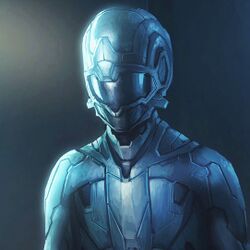

Forerunners
Guardians of the Mantle
Latin Species Name: Primoris prognatus
Homeworld: Ghibalb (original), Maethrillian [The Capital] (primary), The Ark (final)
Technology level: Tier 1
Avg. Height Range: 6ft 6in-13ft 7in (198.1cm-414cm)
Avg. Weight Range: 242lbs-831.4lbs (109.8kg-377.1kg)
Avg. Lifespan: + thousands
Origin
Around 15 million years BCE, the Precursors seeded the Forerunners on the world known as Ghibalb, which would become their nascent homeworld. Their burgeoning civilization quickly rose in technological prowess and eventually gained interstellar travel and the ability to colonize distant worlds. Unfortunately, Ghibalb would be destroyed during a series of ambitious, yet tragic, experiments in stellar engineering. The destruction of Ghibalb would temper Forerunner ambitions in mega-engineering for millennia, but did force a diaspora that would eventually result in the pan-galactic Forerunner empire known as the ecumene.
Downfall
Though thriving for millions of years and achieving extraordinary technological feats, the Forerunners eventually fell prey to the horrific parasite known as the Flood. Their efforts to contain the parasite culminated with the activation of the Halo Array, eliminating all sentient species in the galaxy. It is believed that most perished during the activation of Halo or departed the galaxy shortly thereafter. However, recent evidence (specifically, the pervasiveness of shield worlds and the reemergence of the Didact) suggests that some could have survived.
Physiology
The Forerunners, though technically a single species, organized into rates: distinctive phenotypes that resulted from careful genetic engineering, biochemical manipulation, and gene therapy to align their population into carefully delineated roles in society. Advancement in rank within these rates involved additional augmentations (known as mutations) that prepared them for further education in the sciences and mysteries of their station.
Appearance
Forerunners exhibited substantial morphological differences between and within each rate. Generally speaking, all Forerunners were upright bipeds with two legs, though specifics varied with age, lineage, mutation, and even personal taste.
Philosophy
Most Forerunners were firm adherents to the religio-philosophical beliefs and practices of the Mantle, which formed the basis of all law within the ecumene and dictated that the Forerunners protect and preserve life in the galaxy. The origins of this philosophy were lost to time, but most Forerunners believed it originated from the Precursors and was passed down to their successors.
However, Forerunners often disagreed on how to implement the Mantle’s guidelines, leading to many divergent interpretations of the purpose and goal of the Mantle between each rate.
Technology
Forerunner understanding of the universe and the technological miracles they created was rivaled only by the Precursors. They were proficient at creating and controlling stars, capable of assembling vast artificial worlds, and adept at the construction of artificial intelligences. Yet, it was their mastery of Slipspace that truly set them apart from even the heights of technology achieved by the ancient Humans and San’Shyuum.
Flood
| « | The Flood is a vicious, extra-galactic parasite capable of seizing, converting, and controlling sentient hosts in an effort to perpetuate its kind. —
|
» |
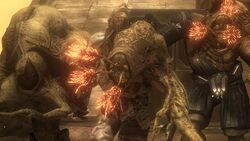
Flood
LF.Xx.3273 [FSC]
Latin Species Name: Inferi redivivus
Homeworld: Extra-galactic, Origin Unknown
Technology level: Native Tier 7/Adopted Tier 2
Avg. Height Range: Varies depending on host
Avg. Weight Range: Varies depending on host
Threat Level: Significant to Serious
Summary
The Flood is a vicious, extra-galactic parasite capable of seizing, converting, and controlling sentient hosts in an effort to perpetuate its kind. The Flood is considered one of the greatest threats to galaxy-wide biodiversity ever and were the reason the Forerunners devised and ultimately activated Halo, wiping out nearly all sentience in the galaxy.
Origin
During the twilight of their civilization, a handful of Forerunners were convinced that the Flood was actually the last remnant of an ancient race of beings--Precursors, the original creators of both humans and the Forerunners. Approximately ten million years prior to the prodigious and legendary Flood War, the Forerunners had violently and preemptively eradicated the Precursors in fear that they were being targeted. The last vestige of the Precursors was a single being and a material which eventually found its way to ancient humans and then to the Forerunners. The Flood was later held in stasis on research facilities for testing, eventually leading to several outbreaks. It is believed all outbreaks were contained successfully.
Flood Super Cell
The Flood is a virulent, parasitic life form originating from and composed of “Flood Super Cells” (FSC), a previously unknown neuron-like cell. These cells (LF.Xx.3273) form the Flood biomass, which can be configured into any shape or muscle necessary to continue and sustain the biological and organizational growth of the parasite. In the latter stages of Food development, the FSC can also be spontaneously generated as the Flood attempts to transform the environment into one more conducive to the growth of the parasite.
Transformation Process
Any significant Flood infestation has always originated with spores or microbiological vectors infecting both sentient and non-sentient species. Eventually the infection transforms into a parasitic strain, causing a sentient agent to convert their biological mass into that of the Flood’s. During this process, a pod-like creature which can vary in size is manufactured containing the necessary form, function, and matter to convert other potential hosts. Though it is not the only way one can be infected, this form is often referred to as an infection form.
Infection Forms
Infection forms, while the most unstable and fragile of Flood forms, are still incredibly dangerous. The infection form is a soft, pod-like carapace standing roughly 90 to 130 centimeters tall. It has numerous tentacle-like appendages serving its locomotive needs and a series red-frond, sensillum-like appendages that act as sensory antennas, honing in on potential hosts. Once an infection form locates a host, it violently attacks them, burying a barb-like appendage into the victim that transmits the virulent FSC. The effect varies though it often results in the “death” of the victim until the FSC takes hold, reviving them into another form—the combat form.
Combat Forms
Combat forms, in most cases, look recognizably similar to their original host. While the host’s body is used, all control has been relinquished, transforming the body into an agent of the Flood. Some of the host’s knowledge and muscle memories are retained in order to aid in the Flood’s growth through the use of available weapons, vehicles, equipment, and even starships. Combat forms maintain the red-frond, sensory antennas of infection forms, which become the creature’s ad hoc central nervous system until it has been completely consumed by the FSC.
Carrier Forms
Carrier forms evolve when the host body starts spontaneously generating infection forms in a bulbous, mass on its back. Eventually, this mass becomes too large to manage and explodes, launching infection forms out to continue the Flood collective’s efforts to dominate their immediate location.
Coordinated Stage
The first indicator of the coordinated stage is found in the atmosphere, as the FSC propagates spores and creates a hive-like carapace holding a warm, humid environment at its center. Most Forerunner containment facilities have artificial weather modulation systems allowing it to generate resistant climates (usually cold, frigid ones), which effectively counteract and slow the Flood’s growth. While environmental conformity is one goal as the Flood speeds toward the coordinated stage, it is not the central focus. The formation of a Gravemind, a centralized intelligence or “Compound Mind,” is necessary in order to continue growth. The rise of a Gravemind usually indicates that the local host species has completely transitioned into the Flood collective and sentient biodiversity has ceased.
Pure Forms
With no remaining local hosts, entry into the coordinated stage is assured while simultaneously becoming a self-damning factor. The lack of viable “food” means that the Flood’s ability to perpetuate their various forms independently has come to an end. With the conversion of the environment and the existence of a centralized intelligence, the Flood can now spontaneously generate new pure forms as well as pure infection forms. The later transpires only if a resurfacing of uninfected sentience occurs. Decoupled from the disadvantages of the host species, the distribution of Flood at this stage is vast and nearly impossible to effectively catalog, particularly since many can spontaneously change into another form at any given time.
Future Growth
After a Gravemind has been fully established, the local Flood infestation will make efforts to leverage any technology and knowledge available to leave their current domain in search of others to infect. This is referred to as the interstellar stage and is only superseded by the Transgalactic stage, when the Flood collective is unified and large enough to move from one galaxy to the next. Effectively, this can only occur when thousands of individual, interstellar stage collectives have uniformly coalesced, spiraling toward the galaxy’s center in a harmonized pattern that ensures no population centers go uninfected.
Solution
During ancient humanity’s first encounter, it is believed that they developed a cure but refused to give this to the Forerunners. The latter eventually resorted to using wide-effect, cross-phased neural displacement (Halo) to wipe out all sentient life (potential hosts) in the galaxy. A belief in the future success of a cure, however, caused the Forerunners to preserve Flood specimens, protected by monitors on various installations throughout the galaxy. Ultimately, this may have been a mistake as it resulted in the resurgence of the Flood in the mid-26th century, as well as the arming of all surviving Halo installations.
Huragok
| « | The Huragok are an artificial species created by the Forerunners for the purpose of maintaining and repairing technology and installations. —
|
» |
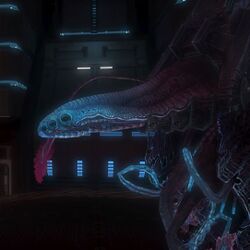

Huragok
Engineers
Latin Species Name: Facticius indoles
Technology level: Indeterminate
Avg. Height Range: 5ft 11in-8ft 2in (180-248cm)
Avg. Weight Range: 123lbs (56kg)
Avg. Lifespan: Indeterminate
Physiology
The Huragok, also known as Engineers, are an artificial species created by the Forerunners for the purpose of, amongst other functions, maintaining and repairing technology and installations over long ages of time. Huragok are not organic, but the composition of nanomechanical substances that look and function like organic material.
Huragok reproduction is almost more mechanical than it is biological, though there are certainly strong similarities. They manufacture their offspring out of readily available organic materials with the deft use of their tentacles’ cilia. The most difficult step for Huragok “parents” lies in the delicate process of attempting to make their creations perfectly buoyant by filling them with the exact right mix of gases. As a result, new Huragok will initially float or sink, which also is directly related to the name their parent units impart on them. Some examples include Far Too Heavy, Quick To Adjust, and Lighter Than Some.
Covenant Service
The Huragok were collected from M-series Forerunner facilities by the San’Shyuum Prophets prior to the establishment of the Covenant. They have been used ever since in the repair, reconstitution, and augmentation of various Covenant technologies. Though this is their primary function, they have others, including the exploration of Forerunner artifacts and the secure transmission of data from one location to another.
Post-War
Engineers were present throughout the Human-Covenant War, though they were rarely witnessed by the UNSC until late in the conflict. Following the war, various Huragok have been strategically employed by the Office of Naval Intelligence (ONI), primarily to assist in reverse-engineering Covenant technology and deciphering Forerunner data-stores. Their assistance has indeed paid fantastic dividends in the form of accelerated technology development and understanding of Forerunner systems. Their continued use is perpetually under scrutiny due to the limited knowledge the UNSC has of these ancient organisms and any hardwired directives that may be exploited by the Didact or other threats.
Humans
| « | Humans are a sentient species, which evolved over one hundred fifty thousand years ago from a simple evolutionary path to an ancient advanced race. —
|
» |
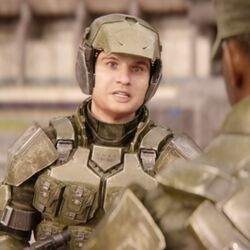
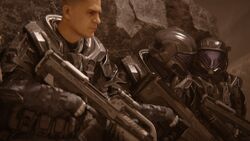
Humans
Reclaimers
Latin Species Name: Homo Sapiens
Homeworld: Earth
Technology level: Tier 3
Avg. Height Range: 5ft - 6ft (152.4-182.9cm)
Avg. Weight Range: 135-200lbs (61.2-90.7kg)
Avg. Lifespan: 80-90 Earth years
Ancient Humans
The earliest known humans, referred to as 'ancient humans,' were a powerful, space-faring species that colonized numerous worlds. They leveraged ancient Precursor artifacts to their benefit, particularly on their primary colony of Charum Hakkor. These ancient humans were physically larger, stronger, and significantly more intelligent on average than contemporary humanity. After their defeat during the Human-Forerunner War, Lifeworkers under the direction of the Librarian subjected humanity to aggressive genetic manipulation and broke them into a variety of subspecies for redistribution on Earth.
Expansion
After the innovation of slipspace travel, humanity quickly pushed out to more distant star systems, building over eight hundred colonies throughout the Orion Arm of the Milky Way by the 26th century. Though internecine conflict threatened to unravel these colonization efforts, the creation of the United Nations Space Command (UNSC) allowed Earth to continue its campaign of rapid colonization and terraforming and suppress insurrectionist efforts. This expansion eventually suffered an enormous and unexpected setback with the arrival of the Covenant. The hostile alien alliance laid waste to nearly all that humanity had attained, before the nearly-30 year war ended in an abrupt and unexpected Covenant defeat.
Government
Most remaining human colonies operate under Unified Earth Government (UEG) administrative control, with the UNSC as the military entity which enforces directives established by the UEG. Though it remains a representative democracy, the UEG is riven by doctrinal and philosophical factions, and struggles with the aftermath of the Human-Covenant War and resurgent independence movements both on Earth and the colonies. For its part, the UNSC has found it difficult to shed governmental tasks it acquired as part of emergency directives during the desperate days of the War. This resulted in what amounts to a shadow government within the human sphere directed largely by the Office of Naval Intelligence (ONI) and its various bureaus.
Earth and Her Colonies
Miraculously, Earth survived the Human-Covenant War and remains humanity’s primary home and cultural heart. Many colonies in the Sol system also survived the Covenant’s final assault relatively intact, including Luna, Mars, and numerous Jovian habitats. Notable extrasolar colonies that survived the Covenant War include New Carthage, Talitsa, Cascade, Terceira, Concord, and Venezia. Some of these worlds remain shaken in the war's aftermath, giving way to civil unrest and, in a few cases, outright rebellion. The UEG and UNSC maintain a tense relationship with these colonies and remains alert to the threat of radical independence movements taking advantage of the power vacuum.
Jiralhanae
| « | Jiralhanae are a large and somewhat primitive bipeds historically deployed by the Covenant as shock troopers. —
|
» |
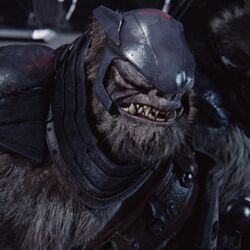
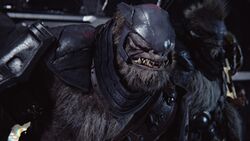
Jiralhanae
Brutes
Latin Species Name: Servus ferox
Homeworld: Doisac
Technology level: Native Tier 4/Adopted Tier 2
Avg. Height Range: 8ft 5in-9ft 2in (259-280cm)
Avg. Weight Range: 1,125-1,500lbs (500-680kg)
Physiology
Jiralhanae, named Brutes by humans, are a large, muscular pseudo-ursine sentient species predisposed to feral behavior. Their home planet Doisac yielded numerous predators throughout its evolutionary history, has aberrant terrestrial conditions and is roughly twice the gravity of Earth. This challenging but diverse environment forced the species to develop from fur-covered, temperamental, tree-dwelling savages into an aggressive species of pack hunters. Jiralhanae are incredibly strong and fast, with highly sensitive olfactory glands, enabling them to hunt down prey quickly even in unfamiliar environments. Without grooming, Jiralhanae become covered in a thick, matted fur which can vary in color but is most commonly brown or black. Beneath their fur is a tough, leathery skin. They have three fingers and an opposable thumb on each hand, with large cloven-toed feet bearing thick, hardened claws.
Sociology
Jiralhanae are a clan-dominated patriarchal society which follows a classical dictatorship from territory to territory. Clans are the most prominent division within their culture, with larger meta-clans or ‘skeins’ forming out of an aggregation of individual groups with common interests. The most powerful clans generally dominate a given skein. The strongest male leads Jiralhanae clans, but Chieftain status can be overturned in an instant if challenged to physical combat. Females serve the role of mother and caretaker solely and are never encountered in combat.
The First Immolation
Prior to their incorporation into the Covenant, the Jiralhanae underwent a brutal decade-long civil war which set their planet ablaze and almost brought them to extinction. Historically, this event is referred to as ‘The First Immolation,’ a nuclear holocaust of such magnitude that it drove them back several hundred years in science and machinery. While the Jiralhanae are, at their base, divided into a vast number of pack-like clans, nearly all these fell into one of two major social divisions or skeins: the Rh’tol or the Vheiloth. These skeins were profoundly different in culture, philosophy, and most importantly their pursuit of power. Eventually they collided when a protracted territorial dispute took a sudden and violent turn. Though most carnage was brief, the aftereffects collapsed all of Jiralhanae society. Both sides would bear survivors, who would later come to fight the Covenant upon its arrival.
Religion
The loose religion Jiralhanae held was simple and based on lunar cycles (as Doisac’s three moons perpetually haunt its skyline). With their introduction to Forerunner theology, the Jiralhanae’s cultural divide between the Rh’tol and the Vheiloth reared its head yet again. The arguably more primitive Rh’tol only believed for strictly practical reasons, ultimately the result of blind subjugation to power. The more sophisticated Vheiloth have historically been far more open to new ideas than their opposites, adopted the Covenant philosophy without challenge, as it helped explain the inner-workings of a great many things. This generated a cultural friction and competitive infighting common to their kind, but for the time being, these tensions were controlled by Covenant leadership. After the Covenant’s destruction, most Jiralhanae survivors have forsaken Covenant beliefs.
The Great Schism
When the High Prophet of Truth rose to power in 2525 CE, he began to perceive cracks between the San’Shyuum and the Sangheili on how to handle the threat of humanity. Pressured by the initial deception which brought him his position, Truth developed a number of schemes that would lead to the replacement of the Sangheili by the Jiralhanae--the latter he viewed as more easily controllable. During this time, a young Jiralhanae named Tartarus, who belonged to the Rh’tol skein, caught his eye. Involved in the initial disputes with the humans, Tartarus had climbed to power by slaying his uncle and gaining authority throughout the entire skein. Truth worked with Tartarus early on throughout the Human-Covenant War, but only late in the conflict did he begin to prepare him for ascension to military authority.
In 2552 CE, Truth began to believe that the end of their campaign against the humans might be at hand. In a brazen move to solidify his base and eliminate the threat of the Sangheili, he armed and positioned Tartarus to lead the entire Jiralhanae power against their naive Sangheilian commanders in a sudden and merciless coup. The resulting conflict would be called the Great Schism, and it would divide the Covenant into two, ultimately forcing the Sangheili out. The outcome, however, would not be the one Truth had desired. A Sangheili commander known as the Arbiter would ally his kind alongside humanity and personally slay both Tartarus and the Prophet of Truth, destroying what was left of the Covenant and bringing about the collective’s dissolution.
Covenant Roles
Upon integration into the original Covenant body, the Jiralhanae held a number of positions. Some of these jobs were simply an extension of their own native, clan-based organizational structure, though it became more formalized while under the banner of the Covenant. Roles included Chieftains, Captains, Stalkers, Majors, and Minors, all splintered into a number of varieties based on skein, functional and organizational placement, and the point it appeared during Covenant history. Since the demise of the Covenant in 2552, these roles have disintegrated to some degree, with many Jiralhanae returning back to their homeworld of Doisac, though some have intriguingly chosen to maintain subservient roles with various Sangheili.
Kig-Yar
| « | The Jackal and Skirmisher are the human names for a saurian species within the Covenant known as the Kig-Yar. —
|
» |
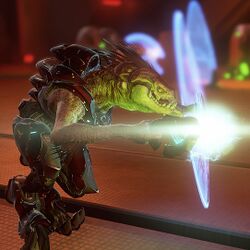
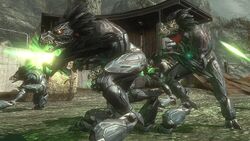
Kig-Yar
Jackal and Skirmisher
Latin Species Name: Perosus latrunculus
Homeworld: Eayn
Technology level: Native Tier 4/Adopted Tier 2
Avg. Height Range: 6ft 2in-6ft 8in (190-203cm)
Avg. Weight Range: 195-206lbs (88-93kg)
Summary
The Jackal and Skirmisher are the human names for a saurian species within the Covenant known as the Kig-Yar. Their physical attributes lend toward scouting and sniper roles, and they are often encountered wielding portable energy shields.
Function
Self-driven and motivated entirely by personal desires and needs, the Kig-Yars’ savage and hostile approach to life has been the source of their greatest resiliency. When the Covenant first arrived with small contingent fleets, the Kig-Yar’s ruthless pirates and mercenaries met the enemy headlong in battle, which began a protracted naval campaign. In the wake of the Covenant’s fall, Kig-Yar society shows the least long-term effects of Covenant influence. In fact, the Kig-Yar ceded nothing culturally during their time in the Covenant, seeing it more as a business arrangement than any true spiritual campaign.
Sociology
Kig-Yar social structure has its roots in an early form of despotic matriarchy. While their global government would later spread power more widely, females remained at the apex of the power structure, controlling not only breeding rights, but also territory, familial organization, and control of major assets. Even within the framework of the Covenant, Kig-Yar female royalty often became shipmistresses within the Navy, effectively managing all combat or patrol engagements. While males made up the bulk of Kig-Yar presence in the Covenant, the real power remained with the females. This matriarchal government continued well after the collapse of the Covenant’s original hegemonic framework and power structure.
Genetic Variety
Unique even among the diverse assortment of client species within the Covenant, the Kig-Yar have shown incredible genetic variation within the species. Most xeno-biologists attribute this unusual variety to specific evolutionary pressures applied by unique ecosystems. The following three physiological types (all males) are the most prolific within the Kig-Yar species, and are the best practical theories to explain their physiology:
Ruutian (Jackals) originated from the continent of Ruuht and has been the most commonly encountered variation within the Covenant. Their most distinctive features are their large, opaque eyes, raised head-quills, and long fringe-toothed avian beak.
T’vaoan (Skirmishers) originated from the asteroid of T’vao. Slightly stronger and quicker, this subspecies carries numerous traits that appear to be new to the Kig-Yar populations. These include a blunt bird-like beak, a hardened callous loreal face-skin, and excessive plumage on head, back and arms. Xenobiologists attribute that the largely isolated populations residing on T’vao have been subjected to the most dramatic environmental conditions. Their asteroid homeworld has significantly higher gravity and a more challenging atmospheric shifts than Eayn itself, favoring Kig-Yar which have developed these impressive avian features.
Ibie’shan (Jackals) originated from the somewhat isolated volcanic island continent of Ibie’sh. As their homeland is not often visited by outsiders, the native communities have developed quite independently. The Kig-Yar who thrive there are believed to have changed the least of the entire species, carrying numerous trace characteristics of the earliest of their kind. These traits include large-toothed reptilian jaws, low-set serpentine eyes, and neck-biased quills that splay downward. While they are surprisingly reptilian, their key physiological traits, intellect, and their ability to effectively breed with other variants Kig-Yar prevent any serious effort at reclassification.
Lekgolo/Mgalekgolo
| « | Hunter is the name for a specific form-based variant of an exotic subsistence gestalt species known as Lekgolo. —
|
» |
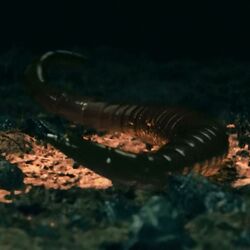
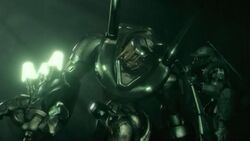
Lekgolo/Mgalekgolo
Hunters
Latin Species Name: Ophis congregatio
Homeworld: Te
Lekgolo Avg. length Range: 52.8 to 61 inches (134-155cm)
Lekgolo Avg. Width Range: 1.6 to 6.5 inches (4.1-16.5cm)
Lekgolo Avg. Weight Range: 12.4 to 67.7 pounds (5.6-30.7kg)
Mgalekgolo Avg. Height Range: 12ft 1in-12ft 3in (368.7-373.4cm
Mgalekgolo Avg. Weight Range: 10,000-11,000lbs (4,536-4,990kg)
Summary
Hunters are a form-based variant of an exotic subsistence gestalt species known as Lekgolo. Used in bonded pairs as highly mobile, heavy armor, Hunters (Mgalekgolo) are one form of several which are leveraged by the Covenant.
Physiology
Individual Lekgolo eels can vary dramatically in length, girth, and weight. Although the Covenant uses individual Lekgolo eels for a number of purposes, the most commonly encountered colony form is that of Mgalekgolo (Hunters). A single Mgalekgolo colony is generally comprised of two “gestalt beings,” each weighing several thousand kilograms and designed to engage in a form of physical combat closely approximated to hunter-killer formations, hence their name. The Covenant further augmented this colony type by heavily arming and armoring the creatures to be even more formidable in combat.
Much of the information on this species is exclusively based on the Mgalekgolo, which unfortunately only hints at the species en total. What is known is that Mgalekgolo can communicate with themselves and other species by wringing and vibrating their elongated component bodies, generating deep, resonating sounds.
Subsistence Gestalt
The Lekgolo exist within densely composited ‘subsistence gestalts.’ This 24th-century xenobiological term describes close-knit extremophilic alien communities that can survive the duress of space for months or even years at a time, with little to no outside resources. The Lekgolo easily represent the most compelling and astounding case of a subsistence gestalt ever encountered, as evidenced by their pervasiveness on the rings around Te over presumably enormous spans of time. Individual Lekgolo eels are not demonstrably intelligent on their own, but when a group forms into a collective, complex neural connections are generated eventually leading to a resilient network for hormonal and bioelectrical functionality. Colonies not only have varying degrees of intellectual capacity (generally associated with neural mass), but they also fill specific caste roles. Although more may exist, the Covenant discovered six specific gestalt types: Dipholekgolo, Mgalekgolo, Rhulolekgolo, Sbaolekgolo, Khantolekgolo, and Thanolekgolo. Each of these differing in mass, size, and complexity, and each working to fit specific functional purposes.
Taming of the Lekgolo
Using primitive versions of the Luminary (a device that could locate Forerunner artifacts), Te was the first known world that the early Covenant alliance had discovered (789 BCE). Not long after arrival it was learned that the Lekgolo were consuming the last vestiges of an ancient Forerunner installation that once orbited Te. For this reason, the Sangheili were sent in to wipe out the Lekgolo species. However, the Covenant quickly realized that waging a war of extermination against trillions of Lekgolo hidden within in the very structures they wished to preserve was a battle they could not win. By 784 BCE, a Sangheili Arbiter proposed they instead assimilate the Lekgolo into the Covenant, capitalizing on the strange species’ abilities for excavation, transportation, and combat.
Covenant Role
Enormous in size and brutal in combat, Hunters are typically deployed as the Covenant’s last resort in any given engagement. Hunters are usually encountered in pairs, one colony comprising two individual Hunters that are often called “bond brothers.” These massive creatures are equipped with a powerful assault cannon and an enormous pavise shield, which is composed of the same material as the battleplate on the Covenant’s immense capital ships. Hunters are unparalleled in size and strength within the Covenant, usually viewing other species as impeding irritations rather than allies, which often results in excessive collateral damage wherever they are deployed.
Sangheili
| « | The Sangheili are a proud warrior race of biped saurians who once served as the enforcers of the Prophets, but now chart a new destiny among the stars. —
|
» |
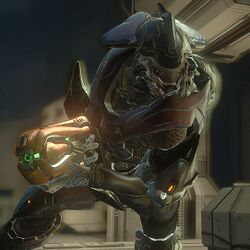
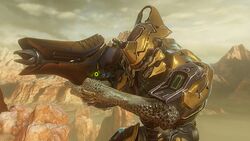
Sangheili
Elites
Latin Species Name: Macto Cognatus
Homeworld: Sanghelios
Technology level: Tier 2
Avg. Height Range: 7ft 4in-8ft 6in (223-259cm)
Avg. Weight Range: 307-393lbs (139-178kg)
Physiology
Sangheili are biped saurians with tall, muscular bodies and elongated heads bearing four mandibles, each laced with sharp rows of teeth; adult Sangheili mandibles can be found in varying shapes, sizes, and ranges of dexterity, and are as distinctive as a fingerprint. Their long, sinewy arms end in zygodactyly hands with impressively dexterous fingers.
Sociology
Divided into clans composed of a tightly-knit families, Sangheili culture has historically been based around a type of feudal manorialism, with multiple allied clan being led by a kaidon who controls a fortified keep and the surrounding territory. This system persists in modified form to the modern era, with major keeps evolving to become city-states that lead alliances of lesser kaidons. On small colonies, a handful of keeps control the entirety of its resources, while on developed worlds, such as Sanghelios, hundreds of keeps vie for power and influence using both politics and military force.
Pre-Covenant
Several hundred years prior to the formation of the Covenant, the Sangheili had developed slipspace technology and created dozens of independent colonies, though their homeworld of Sanghelios remaining central to governance and culture. After a long and bloody war against the San’Shyuum the two species eventually formed a truce, vowing to come together in a union called the Covenant and advance together – united in worship of the Forerunners and dedicated to following their path to transcendence: the Great Journey.
Swords of the Prophets
After the Covenant was formed, the San’Shyuum slowly insinuated themselves into Sangheili culture, gradually replacing their scientific and industrial capabilities and supporting their warlords’ ambitions to focus purely on martial matters. As time passed, other species were given charge over even menial tasks and labor and the entire Sangheili culture was dedicated to waging holy wars and acquiring Forerunner artifacts on behalf of the San’Shyuum Prophets.
Much later, it was the Sangheili that led Covenant forces in a vicious campaign to wipe mankind out. During this protracted war, however, ancient lies and betrayal at the hands of the High Prophet of Truth led to the permanent fracturing of their collective. The resulting Great Schism tore apart the Covenant, though many Sangheili fought only to destroy the Prophets and their Brute allies.
Aftermath
In the aftermath of the conflict and the destruction of the San’Shyuum-led Ministries that had managed the Covenant species’ day-to-day needs, Sangheili society began to fall apart, with their colonies sliding into violent internecine clashes over resources, politics, and influence. Still reeling from these events and divided on their relationship with humanity and their belief in the Forerunner divinity, the once-unified Sangheili splintered into a number of factions with no leader to truly unify their kind, though a few groups have gathered more strength than others.
One of those groups is the Swords of Sanghelios, an ancient order restored by Arbiter Thel ‘Vadam, who seeks to unite his people and return the Sangheili to their ancient independence and nobility. Opposing him are Sangheili warlords such as Jul ‘Mdama, who have slowly put together shattered pieces of the Covenant and reforged it under Sangheili leadership.
San'Shyuum
| « | The San'Shyuum – also known as Prophets – served as the head of the Covenant empire, governing over the Covenant's religious and political concerns, before the fallout of the Great Schism brought their reign to an end. —
|
» |
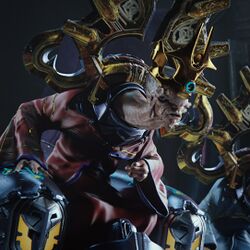
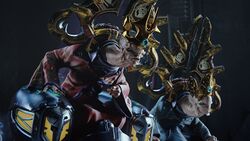
San'Shyuum
Prophets
Latin Species Name: Perfidia Vermis
Original Homeworld: Janjur Qom
Adopted Homeworld: High Charity
Technology level: Tier 2
Avg. Height Range: 7ft-7ft 5in (213.4-226.1cm)
Avg. Weight Range: 179.4-212.9lbs (81.4-96.6kg)
Summary
Known more colloquially as the Prophets, the San’Shyuum were the prime architects of the Covenant and their holy war against the human race. For millennia, the San’Shyuum worshiped the Forerunners as gods, with the basis of their devotion revolving around the concept of transcendence which was connected to an artifact called Halo. As the Covenant’s religious leaders, the Prophets’ main activity was to locate, study, and incorporate Forerunner technology in order to more fully understand and eventually initiate what they believe to be the Great Journey, a pathway into godhood themselves.
Physiology
Most Forerunners records indicate that the San’Shyuum were intelligent and physically attractive creatures during their ancient history on Janjur Qom. Evidence suggests that the Forerunners genetically manipulated the San’Shyuum at the close of the war, which resulted in a tragic physical and cultural reduction of their species as punishment for their alliance with humanity.
Contemporary San’Shyuum are tall, lithe creatures with long serpentine necks and thin, frail skeletal structures which require slow and delicate movement. They are tridactyly-fingered with narrow, highly tactile hands and prehensile (though often atrophied to a point of uselessness) feet. While younger San’Shyuum still walk upright like their ancestors, many adults and elders, particularly those in places of authority, now utilize anti-gravity systems for mobility. Despite their physical impediments, the San’Shyuum have been able to dramatically extend their lifespans through medical advancements, allowing many individuals to live for hundreds of years.
Architecture
Under the preferences of the San’Shyuum, Covenant architecture was primarily comprised of large elegant, sweeping shapes--broad parabolic silhouettes that embellish even the most functional and utilitarian of devices. Covenant metals and stone composites are generally shades of purple and gray, bonded by a variety of exotic alloys using a tight hexagonal mesh.
Pre-Covenant History
After the Librarian’s reseeding of Janjur Qom after the activation of Halo, the San’Shyuum redeveloped technology, language, and philosophy based on their observation of Forerunner artifacts--their species having forgotten the conflict that took place long ago. At around 2200 BCE, two major sects divided San’Shyuum culture which eventually resulted in a vicious and bloody civil war that consumed almost the entire planet. On one side, the conservative Stoics believed Forerunner artifacts were divine and thought by dismantling them they would dishonor the gods who had left them. In opposition were the Reformists, militant progressives who were exhausted with simple, superficial observations and thought the true power of the old gods would be awakened by close study and disassembly.
At the center of the spiritual and scientific dilemma was the Forerunner dreadnought, a massive spaceship which lay at the center of the Great Apothtea sea. The most radical Reformists were eventually able to re-activate the slumbering dreadnought, escaping their planet and leaving the civil war behind. Peace would not last forever though, as a chance encounter with a powerful warrior species known as the Sangheili would pitch the San’Shyuum Reformists into another heated war for control of the Forerunners’ legacy. This conflict nearly spelled doom for both sides until a bargain was struck, and an alliance was formed.
The Covenant
After the penning of the Writ of Union in 852 BCE, what was simply a radical offshoot of the San’Shyuum religion ultimately became a political and military alliance with the Sangheili. This Covenant, as it was called, would eventually incorporate several species from across the Orion Arm into a powerful, unified empire stretching across hundreds of worlds and billions of individuals.
Dissolution
Unfortunately, the San’Shyuum’s ability to maintain the Covenant would eventually disintegrate during the course of their war with the humans, ironically, just as they managed to finally locate the Halo rings. When the future High Prophet of Truth made the discovery that placed the human species at the center of Forerunner prophecy, plans were spun into motion not only to wipe out this new species, but also to break the powerful grip the Sangheili held over the Covenant military--something the Prophets believed would eventually turn against them. Unfortunately, these plans would backfire and the Sangheili would rise against the San’Shyuum, giving the humans victory in the war and ultimately crushing what little was left of their grip on the Covenant empire.
Unggoy
| « | Unggoy are squat, xeno-arthropodal bipeds. They are used as disposable infantry by many Sangheili warlords in the wake of the breaking of the Covenant. —
|
» |
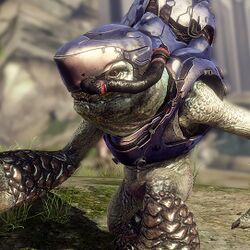
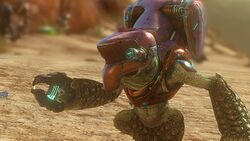
Unggoy
Grunts
Latin Species Name: Monachus frigus
Homeworld: Balaho
Technology level: Native Tier 6/Adopted Tier 2
Avg. Height Range: 4ft 6.5in-5ft 7in (138.4-167cm)
Avg. Weight Range: 248.3-260.1lbs (112.6-118kg)
Physiology
Unggoy, nicknamed Grunts by humans, are squat, xeno-arthropodal bipeds who presumably evolved from smaller amphibious primates. Distinct from many other bipeds, Unggoy hind legs are quite short, adapted more for clambering and crawling over rocky terrain rather than walking upright. Their disproportionately large arms are excellent for grappling and scaling, but often impede movements through narrow corridors or attempts to manipulate small, delicate objects. To deter Balaho's voracious predators, a rigid exoskeleton lined with barbs and spikes covers large portions of their backs, arms, and legs. The Unggoy’s elongated cranium ends in a blunt, bony face, with low-set eyes and a small, straight-toothed mouth. Although many consider this species inherently unintelligent, such assertions are almost certainly an artifact of the Covenant leadership relegating the Unggoy to menial labor and cannon fodder roles. In truth, many Unggoy have proven to be remarkably intelligent, knowledgeable, and resourceful.
Unggoy Rebellion
The most remarkable event in Unggoy history is their rebellion against the Covenant in 2462 CE. In the years just before the rebellion, the Kig-Yar were forced to share habitation with the Unggoy in High Charity’s lower quarters. When Unggoy inadvertently trampled several Kig-Yar nests in the overcrowded warrens, the Kig-Yar seized an opportunity to stifle Unggoy population growth. A cabal of Kig-Yar sabotaged a series of Unggoy recreational infusion dispensers that resulted in the sterilization of a large portion of High Charity's male population--an event referred to as the ‘Infusion Incident.’
When San’Shyuum leaders failed to address the festering conflict, it became a full-blown revolt. The viciousness and surprising bravery of the Unggoy eventually required the application the Covenant’s full military strength and the creation of an Arbiter to put the uprising down. The Arbiter was forced to end the conflict by initiating a limiting razing of Balaho, effectively threatening to exterminate the entire species. When the razing began, the Unggoy quickly abandoned the fight, unwilling to sacrifice their homeworld. The revolt proved to the Sangheili that the Unggoy were more than mere laborers and could be incorporated into the military in meaningful ways. Despite their tragic losses, the rebellion forever changed the Unggoy’s path.
Covenant Roles
When the Covenant came upon vulnerable Balaho in 2142 CE, the Unggoy were aggressively converted and forced into servitude. Though their status increased after the Unggoy Rebellion, they were still considered the lowest caste in the Covenant hierarchy. They served as the first wave of infantry in ground campaigns, deploying in large numbers to undertake a variety of dangerous operational roles. After the end of the Human-Covenant War, many stayed indentured to their Jiralhanae or Sangheili commanders while others fled back to their homeworld.
Yanme'e
| « | Yanme'e are a carnivorous arthropod species encountered in large, tenacious numbers.Humans refer to this species as ‘Drones’ or ‘buggers.’ —
|
» |
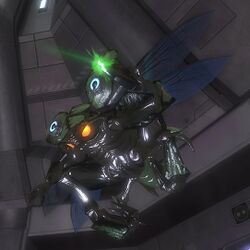
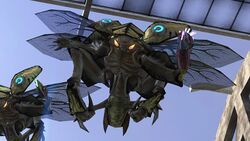
Yanme'e
Drones
Latin Species Name: Turpis rex
Homeworld: Palamok
Technology level: Native Tier 4/Adopted Tier 2 from Covenant
Avg. Height Range: 5ft 10in-6ft 9in (177.8-205.8cm)
Avg. Weight Range: 169.7-279.9lbs (77-127kg)
Physiology
The Yanme’e are sentient carnivorous arthropods with chitinous bioluminescent exoskeletons and two pairs of wings. They are polydextrous--capable of using both their hands and prehensile feet to grasp tools, weapons, and even enemies while in combat. Despite their large size and high-gravity homeworld, Yanme’e are capable of limited flight. These bipedal insectoids evolved from winged tree-dwelling arthropods which had developed complex motor skills through a chitinous, flexible appendage that behaved like an opposable thumb. This advancement led to higher levels of technology, evolved societal coordination and cooperation, and ultimately to contemporary Yanme’e society. Communication between individual Yanme’e occurs both sonically and by way of pheromones, making conversation with other species rare and challenging.
Sociology
Most Yanme'e fall into one of three distinct castes: domestic, worker, or protector, although the Covenant artificially merged the latter two. To outsiders, males and females look extremely similar, though small changes in coloration or silhouette can indicate class and function. Yanme'e queens are substantially larger than the rest of their species with distended abdomens and thick legs. Yanme'e society is driven by an aggressively matriarchal focus, with their various castes supporting each hive's preservation through the orders of their queen. The queen's well-being is paramount to the propagation of the species and their way of life. She is the focal point of all progress, including most major advances in science and technology--most of which have emphasized protection and augmentation of the hives.
Unmutuals
On occasion, some aberrant males (also called “unmutuals”) are born with destructive, social abnormalities that can be incredibly difficult for the hive to manage or maintain. Relatively small in number, these are usually marked and banished, living in small cavernous spaces in between hive territories. With the arrival and species integration into the Covenant body, a notable rise in unmutuals has occurred. This increase was significant enough for the Covenant to set up Kig-Yar-managed penal colonies, forcing unmutuals to benefit the Covenant’s war efforts with hard labor.
Flight
Yanme’e are naturally capable of short bursts of flight on their 2G world of Palamok. When the Covenant discovered them, efforts were made to extend this ability by fixing gravity-dampening modules to their bodies. This adjustment has made Yanme’e impressive fliers, particularly on worlds with less gravity than Palamok. Although Yanme’e were initially leveraged for custodial and maintenance purposes only, their ability to fly became a critical part of their ascent to a combat-functioning role.
Architecture
Hives are composed primarily of mud, wood, and cellulose materials mixed with Yanme’e saliva and feces. While hives can form in any location where sufficient raw material and Yanme’e exist, they are usually found underground or in the vast jungle canopies that cover most of Palamok. Additionally, both Oquiu and Ka’amoti, two of Palamok’s more significant territories, have massive geological structures, which the local Yanme’e have densely packed with hives. Possibly the most intriguing facet of this architecture is that hives can be created at an unbelievably fast rate--with impressively vast structures generated over a matter of hours. Combat-deployed Yanme’e are often ordered to create temporary, makeshift hives as the Covenant military forces their way into enemy territory. This act allows the occupying armies to establish a physical foothold deep within enemy territory, (often hidden on cavernous ceilings or deep underground).
Covenant
Upon the arrival of the Covenant in 1112 CE, the Yanme’e violently resisted the foreign invaders. The Covenant, however, were reticent to destroy Palamok for fear that the hives might guard Forerunner treasures below. Although no evidence of Forerunner residence was found upon later exploration, at the time the San’Shyuum were forced to learn the Yanme’e language and barter deals with their kind. This effort staved off a likely long war due to the Yanme’e’s extraordinary numbers. Yanme’e were integrated into the Covenant en masse, and for years they served in a strictly custodial capacity, although the Covenant eventually developed a variety of combat roles for the species. After the Human-Covenant War subsided, and the Covenant splintered apart, most Yanme’e gladly returned to their native system of Napret.


